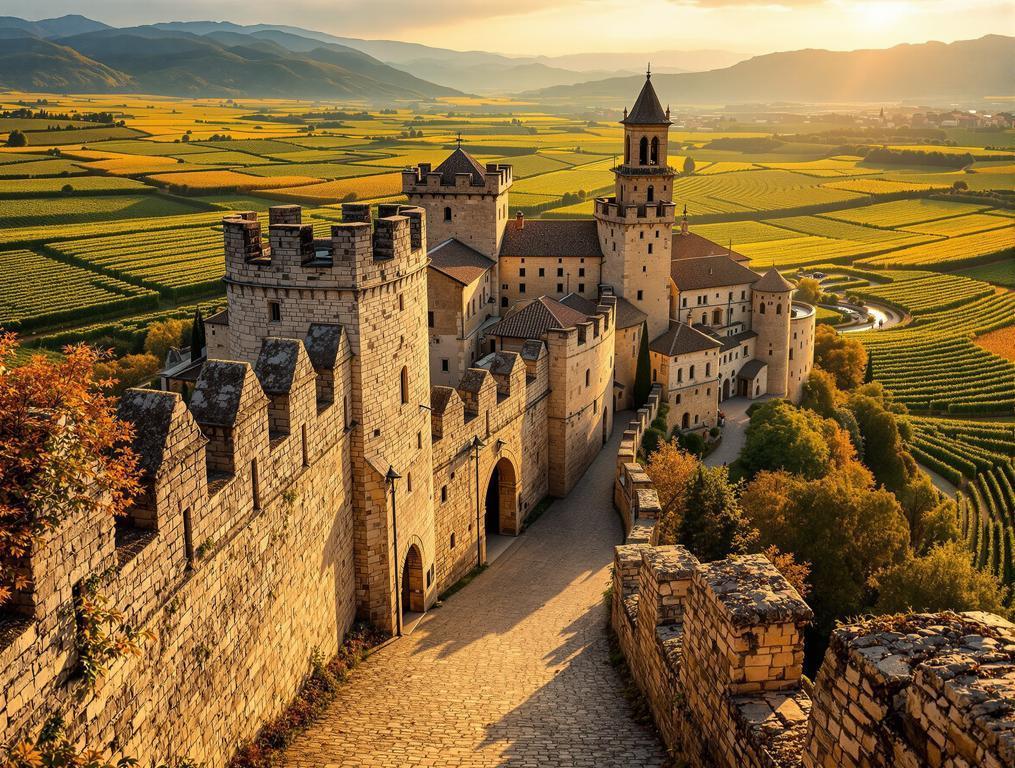I’m winding through Laguardia’s maze of cobblestone streets, the early morning sun catching on ancient stone walls. This Basque fortress town of just 1,500 residents sits atop a hill, surrounded by a patchwork of Rioja vineyards stretching to the horizon. Unlike its famous French cousin Carcassonne, there are no ticket booths or tour buses yet – just five perfectly preserved medieval gateways that have guarded this wine sanctuary for over 1,000 years. What strikes me immediately is how the entire historic core – 70% preserved in just 8.1 square kilometers – feels like a living museum without the crowds.
Why Spain’s medieval wine fortress is about to be discovered
Walking through the Puerta de Carnicerías (Butchers’ Gate), I realize I’ve stumbled upon something extraordinary. While Barcelona attracts millions with its hidden Spanish architectural treasures, Laguardia offers equally impressive medieval structures without the crowds.
This walled town stands at 630 meters elevation, a position that once served military defense but now creates the perfect microclimate for the exceptional Rioja Alavesa wines produced here. The combination is irresistible – 10+ world-class wineries in a fortified medieval town that most international travelers have never heard of.
Similar to how small towns transform through cultural tourism, Laguardia is leveraging its unique wine heritage to create sustainable visitor experiences. But the secret is getting out – and fast.
Spain’s tourism authorities are actively promoting “deconcentration” – shifting visitors away from overcrowded Barcelona and Madrid toward authentic cultural gems. With the vibrant San Juan Festival approaching in late June 2025, this medieval wine fortress sits at the perfect intersection of cultural heritage and oenophile paradise.
5 intact gateways to Europe’s most preserved wine heritage
Each of Laguardia’s five original medieval gates – Mercadal, Carnicerías, Páganos, San Juan, and Santa Engracia – opens to different aspects of the town’s wine soul. While many travelers seek experience authentic Spanish culture away from tourist crowds, Laguardia offers a particularly rich combination of wine heritage and medieval architecture.
Beneath these cobblestone streets lies a network of over 300 underground wine caves – ancient cellars where families have produced Rioja for generations. At Cueva Dorretxe, I descend steep stone stairs into dimly lit chambers where wines age in perfect natural conditions.
“We see maybe twenty visitors on a busy day now. In five years? I worry we’ll be like Saint-Émilion with tour buses and selfie sticks. The authentic experience will disappear. Come now while we’re still ourselves.”
Laguardia’s medieval walls rival other medieval villages with preserved architecture but with the added dimension of world-class wine production. Unlike Carcassonne, which sees over 3 million visitors annually, Laguardia remains blissfully undiscovered.
The density of history per square meter is astounding. Within these walls, I find Casa Primicia – the oldest winery in Rioja Alavesa dating to the 15th century – just steps from the dramatic Plaza Mayor with its automaton clock that performs Basque dances at specific times daily (12, 1, 2, 5, 8, and 10 pm in summer).
What the guidebooks won’t tell you
For the perfect experience, arrive before 9am when the morning light streams through the eastern gates, creating dramatic shadows across the stone walls. While most visitors park outside the northern gate, locals know that free parking near Páganos Gate offers easier access and fewer tourists.
The underground wine caves are coolest (and least crowded) during early weekday afternoons. When locals greet you with “Kaixo!” (hello in Basque), respond with “Egun on!” (good day) for immediate smiles and insider treatment.
After exploring Laguardia, consider extending your Spanish adventure to lesser-known Spanish destinations worth exploring along the northern coast.
Time your visit around June 24th for the San Juan Festival, when bonfires illuminate the medieval walls and wine flows freely during community celebrations. But arrive at least a week before the festival to experience the town’s authentic rhythm before other travelers discover it.
As I sit atop the western wall watching the sunset paint the vineyards gold, my wife Sarah photographs ancient gateways silhouetted against the Rioja landscape. Like the medieval sentries who once guarded these walls against invasion, I find myself selfishly hoping this perfect blend of history and viticulture stays undiscovered just a little longer. The wines of Laguardia have been aging quietly for centuries – perhaps they deserve just a few more moments of peace before they inevitably make headlines.
